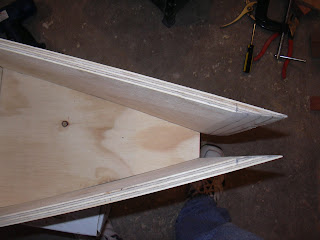

Yesterday, I was able to work on the boat again for the first time in a week due to some traveling and other activities.
As noted before, the stem was not straight in alignment with the center line of the keel, so I decided to see if I could correct this problem.
I took the stem screws out and re-trimmed the notch at the bottom of the stem to make it match the bottom of the keel better. I used my new T-Bevel to accomplish this task, and I am now sure glad I bought it the other day. A cheap tool that will come in very handy in the future.
I also trimmed the left keel side back to match the right side.
I then re-attached the stem with on screw through the bottom of the keel bottom into the notched area of the stem to hold it straight with the center line of the keel. Slowly, I drilled new holes and re-attached the keel sides to the stem again, while my girlfriend held the stem in perfect vertical level in both dimensions, and holding the stem in center alignment with the keel center line. Quite complicated for such a small piece, but it will make a big difference when the boat is completed. Everything needs to be as straight as possible or it will look funny when it is done.
It came out way better this time than the first time when I tried to accomplish it all myself. Thank God for Girlfriends!!!



















